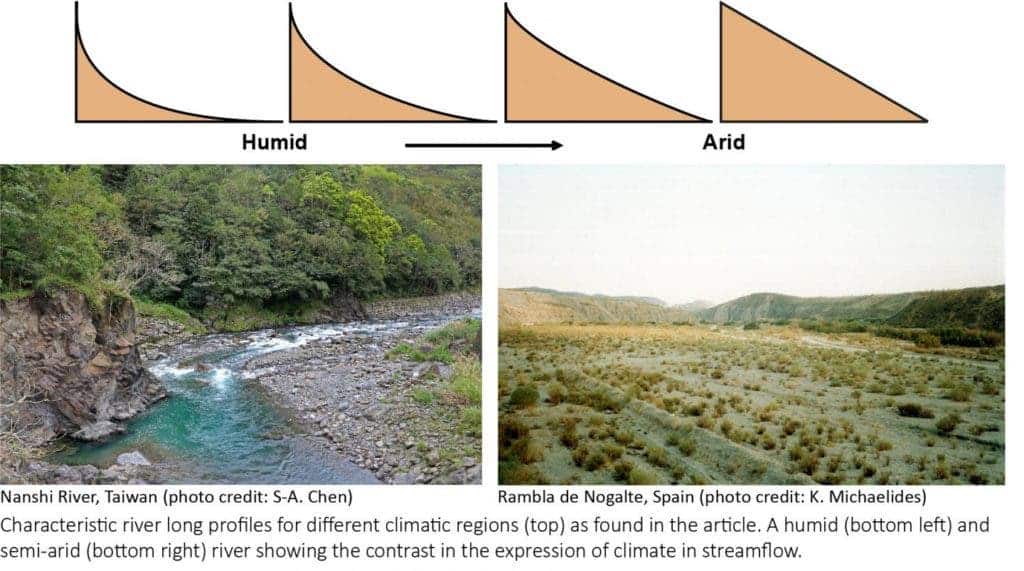
Rivers are essential to mankind. Almost all major cities have been established around rivers. They have been used as a source of water and food since pre-history, and to this day, they are vital for settlements, often serving as an easy means of disposing of wastewater and as a channel for navigation.
Yet much like any other ecosystem, rivers are also affected by the climate. Researchers have known this for a while, but they’ve struggled to detect the influence of climate on the formation and evolution of rivers.
Rivers typically flow somewhere higher to somewhere lower. If you’d make a profile of a river, you’d end up with a path that descends in elevation — that’s pretty straightforward gravitationally, but the shape of this gradient is quite important.
According to conventional wisdom, these river profiles have a concave-up shape (similar to the inside of a bowl), with fluctuations serving as markers of interference from climate, tectonics, lithology, or human impact. However, not all rivers play by this rule. Some rivers have profiles with an almost zero concavity — in other words, they have almost ramp-like straight profiles.

It’s not exactly clear why this variation in profile shape happens, but a new study might shed some light on that. The new research suggests that the shape of the river is essentially a signature of the long-term climate in the area: humid climates have more concave profiles whereas arid rivers have ramp-like profiles.
Lead author Shiuan-An Chen from the University of Bristol’s School of Geographical Sciences, said this comes as no surprise:
“The long profile is formed gradually over tens of thousands to millions of years, so it tells a bigger story about the climate history of region. We would expect climate to affect the river long profile because it controls how much water flows in rivers and the associated force of water to move sediment along the riverbed.”
It has traditionally been suggested that these shape variations are connected to climate, which makes sense. After all, climate directs rainfall, which in turn affects runoff and erosion, and further influences sediment deposition. But up until now, researchers lacked a systematic dataset of river profiles, spanning all the areas of Earth. Chen and colleagues produced this database (also making it freely available for anyone to use and study).
The data for the river profiles came from NASA satellites and includes observations on over 330,000 rivers from all across the globe. It’s the first study that shows distinct river shapes across the different climate zones.
In humid regions, rivers tend to have consistent flow all year round. This means they continuously bring up sediment and erode the profile to a more concave shape until an equilibrium is reached. As the climate becomes drier, rivers cause less erosion, and in the aridest climates, the flow is very inconsistent. Using a numerical model which simulates river evolution, researchers were able to back up their observations and confirm that indeed, the climate is the main driver of this change.
Dr. Katerina Michaelides, also from Bristol’s School of Geographical Sciences, who led the research, added:
“Traditional theory included in textbooks for decades describes that river long profiles evolve to be concave up. Existing theories are biased towards observations made in humid rivers, which are far better studied and more represented in published research than dryland rivers.”
“Our study shows that many river profiles around the world are not concave up and that straighter profiles tend to be more common in arid environments.”
However, Michaelides also draws attention to the fact that most studies on rivers focus on areas where people tend to live — as a result, we know less about the rivers in the driest areas.
“I think dryland rivers have been understudied and under-appreciated, especially given that drylands cover ~40% of the global land surface. Their streamflow expression gives unique insights into the climatic influence on land surface topography,” she adds.
There is another important takeaway in this study: with the advent of both satellite data and high-power computing, researchers have unprecedented access to tools to study the Earth.
The study ‘Aridity is expressed in river topography globally’ by S-A. Chen, K. Michaelides, S. Grieve and M.B. Singer, has been published in Nature.






